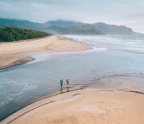Lifeblood of the nation

IT’S DUSK AND the late afternoon sun has lit up the Barwon River’s banks in an orange glow, illuminating the pink beaks of pelicans patiently perched on the Ngunnhu (Brewarrina Fish Traps).
Below the modern Brewarrina Weir in north-western New South Wales, a 2km bend holds the remains of this ancient structure, a complex of dry-stone walls and a site of engineering brilliance. Displaying advanced knowledge of river hydrology and fish ecology, the traps were designed to catch Murray cod, golden and silver perch and other fish, but allow breeding stock to pass through.
Ngunnhu (pronounced noon-oo), which is believed to be one of the oldest, if not the oldest, human-made constructions on Earth has national heritage listing. The Ngemba traditional owners say their creative spirit, Baiame, instructed neighbouring tribes to share and work together to construct Ngunnhu, allocating responsibility over particular traps to each family group. Here they took part in ceremonies, traded and feasted.
Despite a troubled colonial history – deeply marred by massacres and later the corralling of people from as far as the NSW south coast onto a mission up the river, and the subsequent dismantling of and damage to the traps – this powerful place has never lost its significance to Aboriginal people. When rain came in early 2020 and the river flowed again after months of being dry, the townsfolk came to dance, swim and fish, along with 800 or so pelicans and flocks of other birds that aggregated here.
I meet with Lily Shearer and other local women, all keen fishers, who belong to an Aboriginal women’s water alliance, which began when many towns ran out of water or it became too foul to drink and they had to rely on donated bottles. She describes this meeting place with its ochre beds, stone quarry and burial ground as the “capital city of the west” and the “landscape parliament”, thought to be tens of thousands of years older than Egypt’s pyramids.
Further downriver, at the Brewarrina Aboriginal Cultural Museum, I’m led on a tour by guide Bradley Hardy, who describes his ancestors as architects, builders, river environmentalists, farmers and bakers who for thousands of years shared the country with giant animals. A 35,000-year-old diprotodon, with a spear head inside it, was found near here. “The river’s our blood,” Bradley says. “If we lose the river we die.”
At the time of colonisation, the British were mystified about where the inland rivers of NSW flowed, with many believing they emptied into an inland sea or even flowed all the way to the Indian Ocean. So
You’re reading a preview, subscribe to read more.
Start your free 30 days



